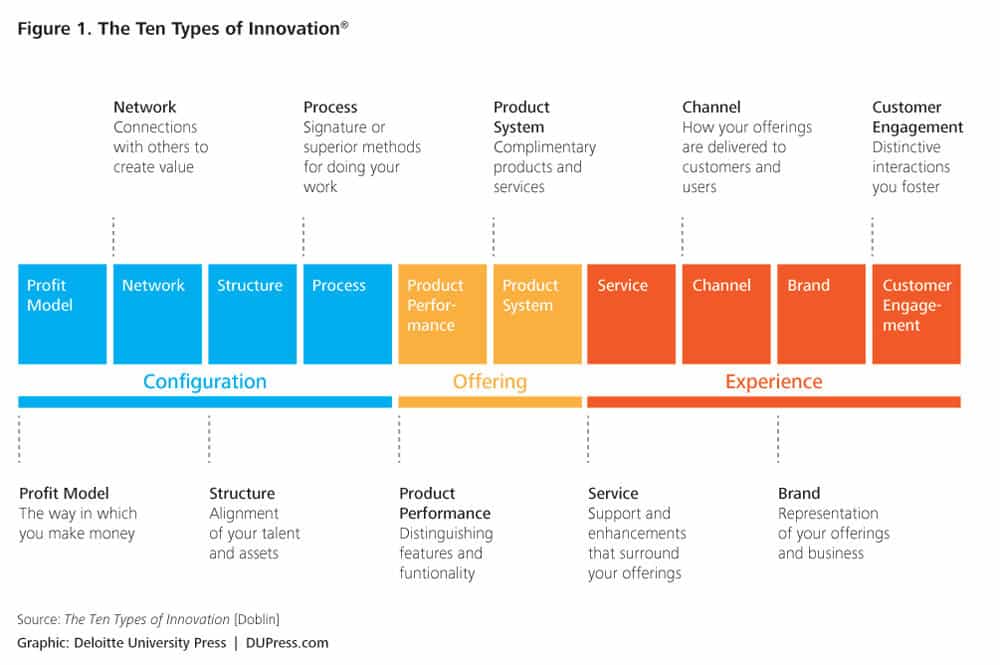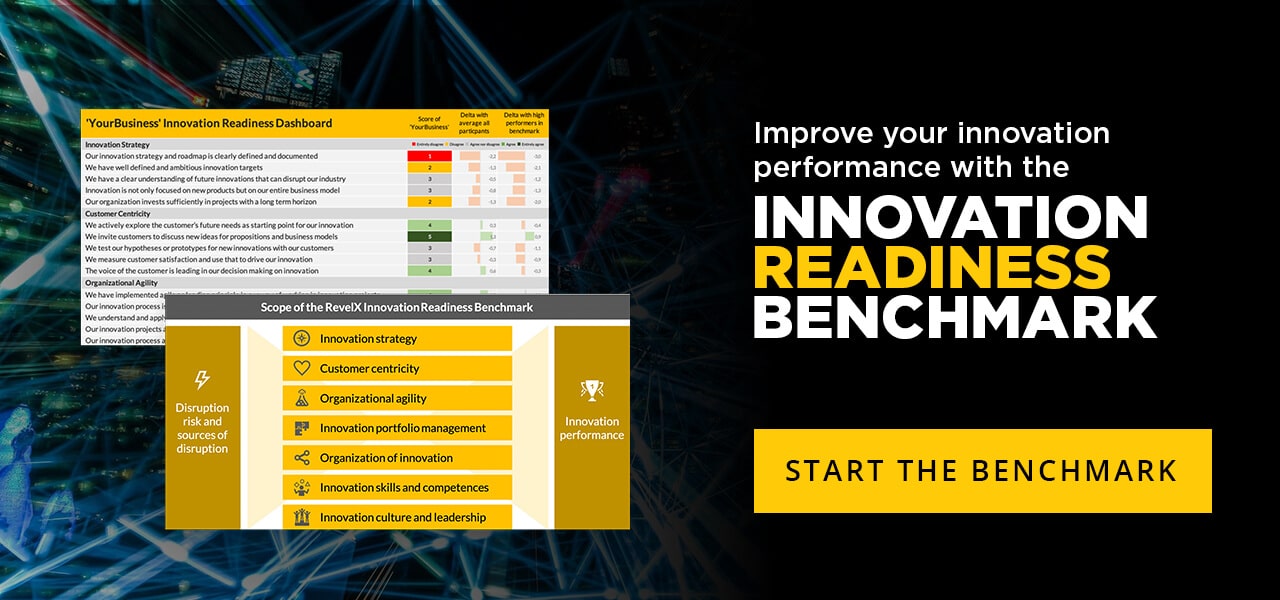This post is the first of three that aims to introduce 3 winning models for innovation, when and how to use them. We thereby address one of the most common and easily underestimated problems that organisations find when they embark on an innovation program: Where are the killer ideas going to come from? In this post we focus on the first well known model: Ten Types of Innovation.
Crowdsourcing for ideas became very fashionable over the last decade although, like all fashions, it seems to have had its day – certainly as a sustainable way of getting a stream of ideas because;
- It’s based on a flawed assumption that there already has to be a great idea out there – we just need to ask enough people. Why should there be?
- The kind of public forums used in crowdsourcing where people post their ideas for others to rate and comment on can easily deter the people with really novel ideas for fear of looking silly
So if you are running an innovation program and find yourself with a large number of ideas, most of which aren’t particularly novel or transformative, you might want to consider how you are asking for ideas.
If you want the ‘un-obvious’, the novel and possibly disruptive ideas, then ask for them in an un-obvious, novel and disruptive way.
Ten types of Innovation is a tool that you can use on a weekly basis but before we get too involved in the tool, let’s quickly examine why and how a different ideation technique will make a difference. To do that, let’s first take a minute or two to understand what are ideas and how to get more of them.
The simplest way of describing an idea is this: imagine the box below on the left is a little slice of our brains. It’s full of ‘stuff’, things we’ve seen, read, learnt and experienced. Every day we live, we see and experience more ‘stuff’. Ideas happen (the box on the right) when we make a new connection – we see something new which makes a connection or connections with the ‘stuff’ already there.

That’s it. The more connections we make, the more ideas we have. It’s why retailers like Ikea spend so much on instore displays – the more visual triggers they show the customer, the more ideas they have, the more they spend.
This concept deliberately challenges some of the common myths around ideas: that they just happen, it’s some kind of magic, luck or serendipity or that ideas can’t be forced.
The more we help people make connections in their minds, the more ideas we will get.

The science behind ideas is utterly fascinating and ‘Where Ideas Come From’ by Stephen Johnson is essential reading (or watch his TED Talks).
We will be discussing the role of location in creativity in the next post, but let’s now look at the first of our ideation tools.
Tool #1: Ten Types of Innovation
The tool was developed in the late 90’s by Larry Keeley of the Doblin group. Doblin is now part of Deloitte, and the framework has been encapsulated into a book of the same name.
The Ten Types of Innovation model is valuable because it helps you identify innovation across the entire business life-cycle. It achieves this by identifying ten different types in three distinct areas.

The first area is ‘Configuration’. This area focuses on the internal and external environment of the company, how the company is designed to make a profit, how talent and assets are aligned and what the processes are to reach that profit. It can also be seen as what the company does and how it’s organized to do that.
The next area, the ‘Offering’ deals with both the products you sell and the complimentary products and services. It is what the company delivers to its customers.
The last area is the ‘Experience’ which focuses on the contact with the customer by breaking the experience up into customer service, customer engagement, brand, and the channels through which the company offers their products. One can also see this as how the company delivers its products and services and how it interacts with its customers.
Using the Ten Types of Innovation
By breaking up the entire life-cycle into ten distinguished parts, the model guides you to think about how you can innovate in less obvious areas of your business such as the business model or customer support rather than just developing new products. Following this logical order ensures that innovation can be implemented in a similarly logical fashion.
Doblin, creators of the Ten Types of Innovation model offer six principles for using the method;
- Understand all Ten Types:Virtually all projects can improve just by knowing and deeply understanding the value and subtleties of each of the types.
- De-emphasize reliance on products and technology:These are the easiest capabilities for competitors to copy.
- Think about categories as well as types:Consciously try to imagine new ways to configure assets, build platforms, and foster fresh experiences.
- Use the types that matter most:Use diagnostics to understand which types you and others in your industry tend to overlook.
- Understand what your users really need:User research can help you know what is relevant to customers and what surprises other types might help to deliver.
- Use enough of the types to make a splash:Using 5 or more types, integrated with care, is nearly always enough to reinvent a category and become newsworthy
Once a type has been identified you can do some research and bring examples of innovation in those areas as triggers. So, if you were focusing on business model you might want to use, as a jumping-off point, examples of innovative models such as monetizing a service rather than a product, metered usage or some of the emerging models from the Shared Economy.
The clearest advantage of this model however comes when different types are combined – for example looking for ways to innovate how you combine your Network (from the Channel area) and Customer Engagement (from the Experience area).
Compared to the S&P list of the top 500 companies those that integrated multiple types of innovations were more successful over a period of time. You can see clearly the results of those companies with five or more of the ten types.

If there is a disadvantage of the model it’s that it is easy to spend a lot of time looking for innovations in areas where there is little to be gained and is thus less applicable when the problem you’re looking to fix is clearly defined.
5 Tips for working with the model
Based on our experience in facilitating numerous workshops and other client interactions whilst using Ten Types of Innovation as a model, the following tips may help you to be effective using the model.
- 10 minute brainstorm rounds, in our opinion, seem to be the most effective.Split your audience/participants into small teams and for each round brainstorm on one of the Ten Types. So in total (and including introduction / wrap-up), you will need around 3 hours to cover all of the Ten Types effectively.
- Put posters or brown paper on the wall for each of the Ten Typesand ask the teams to write their ideas on sticky notes and place them on the posters.
- Quantity > quality, initially.In order to start everyone’s brainstorm engine, we find it is best to stimulate ideation by asking participants to come up with as many ideas as they can and not worry about their quality. Fill those posters! You’ll prioritize later.
- Having come up with 100+ or-so ideas, it is time to cluster (per theme) and prioritize.Great frameworks for doing this are the Ansoff Matrixand Eisenhower Matrix, both management classics but well suited for the job.
- Consider buying the awesome tactics cards that Doblin created to bring your brainstorm to a higher level. The set includes 114 individual innovation tactic cards that will definitely help you think outside of current business & established patterns.
Matthijs Rosman
Trusted and creative advisor. Specialist in growth acceleration and innovation. Combines analysis and creativity to develop surprising combinations. From new digital possibilities to ways to improve commercial results. Cordial towards others, sharp on details. Continuously looking for growth opportunities.
Related posts
Future-proofing the Legal Industry: How Innovation Management is reshaping Law Firms
Explore how lawyers can transform their business…
March 28, 2025
Navigating tomorrow: empowering companies through Futures Thinking for strategic success
Leveraging Futures Thinking to uncover opportunities,…
March 28, 2025
The power of AI enhanced innovation software
Unique integration of RevelX’ best practices embedded in…
March 12, 2025




